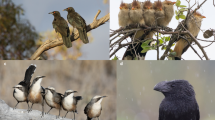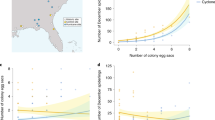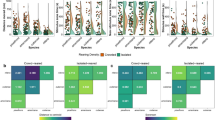Abstract
Group selection may be defined as selection caused by the differential extinction or proliferation of groups1,2. The socially polymorphic spider Anelosimus studiosus exhibits a behavioural polymorphism in which females exhibit either a ‘docile’ or ‘aggressive’ behavioural phenotype3,4. Natural colonies are composed of a mixture of related docile and aggressive individuals, and populations differ in colonies’ characteristic docile:aggressive ratios5,6. Using experimentally constructed colonies of known composition, here we demonstrate that population-level divergence in docile:aggressive ratios is driven by site-specific selection at the group level—certain ratios yield high survivorship at some sites but not others. Our data also indicate that colonies responded to the risk of extinction: perturbed colonies tended to adjust their composition over two generations to match the ratio characteristic of their native site, thus promoting their long-term survival in their natal habitat. However, colonies of displaced individuals continued to shift their compositions towards mixtures that would have promoted their survival had they remained at their home sites, regardless of their contemporary environment. Thus, the regulatory mechanisms that colonies use to adjust their composition appear to be locally adapted. Our data provide experimental evidence of group selection driving collective traits in wild populations.
This is a preview of subscription content, access via your institution
Access options
Subscribe to this journal
Receive 51 print issues and online access
$199.00 per year
only $3.90 per issue
Buy this article
- Purchase on Springer Link
- Instant access to full article PDF
Prices may be subject to local taxes which are calculated during checkout


Similar content being viewed by others
Change history
26 February 2021
Editor's Note: Readers are alerted that the reliability of some of the data presented in this Article is currently in question and is being investigated by the editors. A further editorial response will follow when the issues are resolved.
06 March 2023
This article has been retracted. Please see the Retraction Notice for more detail: https://doi.org/10.1038/s41586-023-05882-3
References
Wade, M. J. Critical-review of models of group selection. Q. Rev. Biol. 53, 101–114 (1978)
Wilson, D. S. The group selection controversy—history and current status. Annu. Rev. Ecol. Syst. 14, 159–187 (1983)
Pruitt, J. N. Behavioural traits of colony founders affect the life history of their colonies. Ecol. Lett. 15, 1026–1032 (2012)
Pruitt, J. N. A real-time eco-evolutionary dead-end strategy is mediated by the traits of lineage progenitors and interactions with colony invaders. Ecol. Lett. 16, 879–886 (2013)
Pruitt, J. N. & Riechert, S. E. Frequency-dependent success of cheaters during foraging bouts might limit their spread within colonies of a socially polymorphic spider. Evolution 63, 2966–2973 (2009)
Riechert, S. E. & Jones, T. C. Phenotypic variation in the social behaviour of the spider Anelosimus studiosus along a latitudinal gradient. Anim. Behav. 75, 1893–1902 (2008)
Wilson, D. S. & Wilson, E. O. Rethinking the theoretical foundation of sociobiology. Q. Rev. Biol. 82, 327–348 (2007)
Wilson, D. S. Theory of group selection. Proc. Natl Acad. Sci. USA 72, 143–146 (1975)
Goodnight, C. On multilevel selection and kin selection: contextual analysis meets direct fitness. Evolution 67, 1539–1548 (2013)
Maynard Smith, J. & Wynne Edwards, V. C. Group selection and kin selection. Nature 201, 1145–1147 (1964)
Williams, G. C. Adaptation and Natural Selection: A Critique of Some Current Evolutionary Thought (Princeton Univ. Press, 1972)
West, S. A., Griffin, A. S. & Gardner, A. Social semantics: how useful has group selection been? J. Evol. Biol. 21, 374–385 (2008)
Pruitt, J. N. & Riechert, S. E. Sex matters: sexually dimorphic fitness consequences of a behavioural syndrome. Anim. Behav. 78, 175–181 (2009)
Duncan, S. I., Riechert, S. E., Fitzpatrick, B. M. & Fordyce, J. A. Relatedness and genetic structure in a socially polymorphic population of the spider Anelosimus studiosus. Mol. Ecol. 19, 810–818 (2010)
Maynard Smith, J. Group selection. Q. Rev. Biol. 51, 277–283 (1976)
Gardner, A. & Grafen, A. Capturing the superorganism: a formal theory of group adaptation. J. Evol. Biol. 22, 659–671 (2009)
West, S. A., Griffin, A. S. & Gardner, A. Social semantics: altruism, cooperation, mutualism, strong reciprocity and group selection. J. Evol. Biol. 20, 415–432 (2007)
Gardner, A., West, S. A. & Wild, G. The genetical theory of kin selection. J. Evol. Biol. 24, 1020–1043 (2011)
Wade, M. J., Bijma, P., Ellen, E. D. & Muir, W. Group selection and social evolution in domesticated animals. Evolutionary Applications 3, 453–465 (2010)
Muir, W. M. Group selection for adaptation to multiple-hen cages: selection program and direct responses. Poult. Sci. 75, 447–458 (1996)
Wade, M. J. Experimental-study of group selection. Evolution 31, 134–153 (1977)
Bijma, P., Muir, W. A. & Van Arendonk, J. A. M. Multilevel selection 1: quantitative genetics of inheritance and response to selection. Genetics 175, 277–288 (2007)
Ingram, K. K., Pilko, A., Heer, J. & Gordon, D. M. Colony life history and lifetime reproductive success of red harvester ant colonies. J. Anim. Ecol. 82, 540–550 (2013)
Gordon, D. M. The rewards of restraint in the collective regulation of foraging by harvester ant colonies. Nature 498, 91–93 (2013)
Eldakar, O. T., Dlugos, M. J., Pepper, J. W. & Wilson, D. S. Population structure mediates sexual conflict in water striders. Science 326, 816–816 (2009)
Aviles, L. Interdemic selection and the sex-ratio—a social spider perspective. Am. Nat. 142, 320–345 (1993)
Colwell, R. K. Group selection is implicated in the evolution of female-biased sex-ratios. Nature 290, 401–404 (1981)
Pruitt, J. N., Riechert, S. E. & Jones, T. C. Behavioural syndromes and their fitness consequences in a socially polymorphic spider, Anelosimus studiosus. Anim. Behav. 76, 871–879 (2008)
Pruitt, J. N., Cote, J. & Ferrari, M. C. O. Behavioural trait variants in a habitat-forming species dictate the nature of its interactions with and among heterospecifics. Funct. Ecol. 26, 29–36 (2012)
Acknowledgements
We are indebted to S. E. Riechert for her assistance with the design and implementation of this experiment, and to J. Troupe and J. Taylor for their assistance with establishing and censusing colonies. J. E. Strassmann and W. P. Carson were invaluable in aiding in the submission of this paper. We thank M. Rebeiz for recommending that we compare colonies composed of native versus foreign individuals. S. M. Bertram, E. M. Jakob, C. N. Keiser, C. M. Wright, N. Pinter-Wollman, J. M. Jandt and A.P. Modlmeier provided helpful comments on this paper. Funding for this work was provided by a National Science Foundation grant to J.N.P. (IOS #1352705).
Author information
Authors and Affiliations
Contributions
J.N.P. designed the experiment, performed the experiment, and wrote the manuscript. C.J.G. assisted with data analyses and writing of the manuscript.
Corresponding author
Ethics declarations
Competing interests
The authors declare no competing financial interests.
Additional information
The source data for this manuscript have been deposited in the Dryad Digital Repository (http://dx.doi.org/10.5061/dryad.87g80).
Extended data figures and tables
Extended Data Figure 1 The heritability of the docile/aggressive phenotype as estimated by offspring on mid-parent regression.
Dams and sires were mated randomly and three female offspring were randomly selected from each brood for assays. The average inter-individual distance score of the three female offspring was regressed on mid-parent inter-individual distance. The slope of the resulting regression provides the estimate of heritability (h 2 = 0.66).
Extended Data Figure 2 The average group size, number of social parasites, numbers of prey captured in colonies’ webs, and the proportion of egg cases cannibalized at the height of the reproductive season for three high-resource sites and three low-resource sites.
The sites looked at were Little River (LR), Melton Hill (MH), Moccasin Creek (MC), Clinch River (CR) Don Carter (DC), Norris Dam (NR). Data presented here represent the averages obtained from 20 randomly selected naturally occurring colonies at each site. Error bars represent standard error of the mean.
Extended Data Figure 3 A figure depicting the relationship between colony extinction and two ecological variables: the number of social parasites (heterospecific spiders) and the proportion of egg cases cannibalized at the time of colony extinction.
Colony extinction events were associated with social parasite presence in high resource populations and egg case cannibalism in low resource populations. Error bars represent standard error of the mean.
Supplementary information
Supplementary Information
This file contains Supplementary Text. (PDF 1576 kb)
Supplementary Data
This file contains Supplementary Data. (XLSX 138 kb)
PowerPoint slides
About this article
Cite this article
Pruitt, J., Goodnight, C. RETRACTED ARTICLE: Site-specific group selection drives locally adapted group compositions. Nature 514, 359–362 (2014). https://doi.org/10.1038/nature13811
Received:
Accepted:
Published:
Issue Date:
DOI: https://doi.org/10.1038/nature13811
This article is cited by
-
How a scandal in spider biology upended researchers’ lives
Nature (2022)
-
‘Avalanche’ of spider-paper retractions shakes behavioural-ecology community
Nature (2020)
-
Scientific Discovery and Inference: Between the Lab and Field in Biology
Topoi (2020)
-
Predictors of colony extinction vary by habitat type in social spiders
Behavioral Ecology and Sociobiology (2020)
-
Are personalities genetically determined? Inferences from subsocial spiders
BMC Genomics (2019)
Comments
By submitting a comment you agree to abide by our Terms and Community Guidelines. If you find something abusive or that does not comply with our terms or guidelines please flag it as inappropriate.



